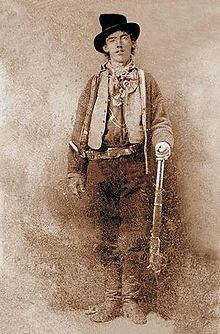BILLY THE KID (c. 1856-1881)

Portrait photograph of Billy the Kid
Billy the Kid was an outlaw whose legend has come to overshadow any personal or historical significance he may have had. It has not been satisfactorily documented when and where he was born, although it has been established that his actual name was Henry McCarty. In 1880 in Fort Sumner, New Mexico, McCarty (alias Billy Antrim, Henry Antrim, Kid Antrim, Billy Bonney, William H. Bonney, and Billy the Kid) told a federal census taker that he was twentyfive years old, that both of his parents had been born in Missouri, and that he too had been born there. There is no reason to believe he was lying. It can be documented that in 1866 he was living in Marion County, Indiana, with his mother, Catherine McCarty, and his elder brother, Joseph McCarty. Catherine McCarty suffered from tuberculosis, and this may have prompted her to move farther west. In 1873 Billy's mother married William H. Antrim in Santa Fe, New Mexico. Shortly after his mother's death in 1874, he took to wandering and spent two years as a general laborer, cowboy, and teamster in eastern Arizona.
Only four killings can be documented against the Kid. The first occurred in 1877 at Camp Grant, Arizona, when Billy shot and killed Frank "Windy" Cahill after an argument turned violent. The Kid was found guilty of "criminal and unjustifiable" shooting, but he escaped from custody and returned to New Mexico. The Kid's other killings resulted from his involvement in the Lincoln County War, a deadly feud involving local merchant and cattle interests. On one side stood Scottish lawyer Alexander Mc- Sween and John H. Tunstall, an Englishman who owned a cattle ranch in Lincoln County. On the other were James Dolan and Lawrence Murphy, merchants in the town of Lincoln. In January 1878 the Kid was working for Tunstall. When Tunstall was murdered by the Murphy- Dolan faction, the Kid and other Tunstall- McSween allies declared themselves "Regulators" and sought revenge.
For the next year bloody retaliatory warfare was waged between the two factions. In early March the Regulators arrested and then killed Dolan associates Frank Baker and Billy Morton, reportedly while the pair were trying to escape. At that point, territorial governor John Axtell declared the Regulators outlaws; after that they were hunted. On April 1, 1878, when Sheriff William Brady and Deputy George Hindman, both Dolan allies, tried to ambush McSween, the Regulators fought back and killed the lawmen. Three days later the Regulators battled "Buckshot" Roberts, a heavily armed bounty hunter, at Blazer's Mill. Roberts and Dick Brewer, a Regulator, were killed in the gunfight. The decisive battle of the Lincoln County War was fought during a five-day shoot-out in Lincoln in July 1878. Sniping went on for four days, with the Regulators trapped inside McSween's house. On the fifth day, after the ineffective U.S. Army arrived, McSween's home was set on fire, and the Kid led a rush out of the burning house. The Kid managed to escape, but McSween and several others were riddled with bullets.
Along with what was left of the Regulators, the Kid was outlawed for good. In December 1880 the newly elected sheriff of Lincoln County, Pat Garrett, and other lawmen captured the Kid at Stinking Springs. There were two federal indictments open against the Kid. The first was for killing Buckshot Roberts, the second was for the death of a clerk on the Mescalero reservation. The prosecution decided that both of these charges would probably result in acquittal, so it was decided to try the Kid for the murder of Sheriff Brady. The Kid was found guilty and sentenced to hang, but he escaped on April 28, 1881, after killing two guards. The Kid was shot to death on the night of July 14, 1881, killed by Pat Garrett during an ambush at old Fort Sumner.
Hundreds of books, motion pictures, radio programs, television programs, and even a ballet have subsequently been inspired by the legend of Billy the Kid. As a legend, the Kid is open to a variety of interpretations, principally as a good man who went bad, as a bad man who remained bad, as a good man who was falsely persecuted. Historians, too, have been guilty of using the Kid's life to prove some thesis or another about his true nature. None of this has anything to do, of course, with the historical Billy the Kid who probably killed only four men, generally in circumstances that might be conceived of as selfdefense, and who was unfortunate enough to find himself on the losing side in a mercantile war.
See also WAR: Lincoln County War.
Jon Tuska Golden West Literary Agency
Fulton, Maurice Garland. History of the Lincoln County War. Tucson: University of Arizona Press, 1968.
Tuska, Jon. Billy the Kid: His Life and Legend. Albuquerque: University of New Mexico Press, 1997.
Previous: Bean, Judge Roy | Contents | Next: Bonnie and Clyde
XML: egp.law.007.xml
